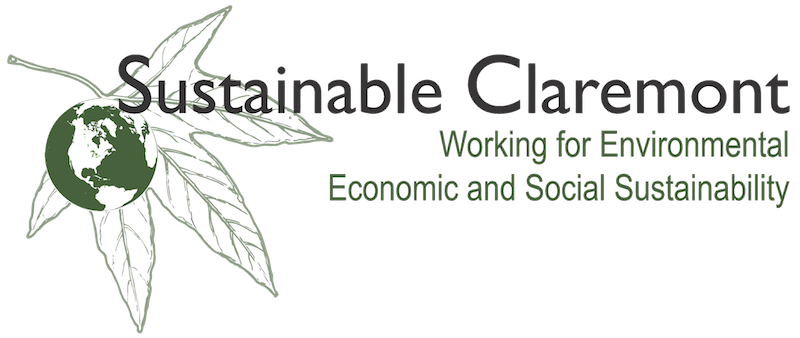There are compelling economic and environmental reasons to recycle and reduce solid waste. Claremont is doing quite well. Our Sustainable City Plan includes a goal of diverting 70% of waste from landfills by 2010 and we almost met that target with a 67% reduction. That is better than most cities. Still, Claremont’s waste management budget for the last fiscal year was close to $1 million to handle 36,000 tons of waste. How much more could be diverted and how much money could be saved? We began to wonder after hearing Terry Grill talk about “Toward Zero Waste” at the March Sustainability Dialog.
Terry told us that some California cities have set a goal of zero waste (actually they mean 90% reduction). To me that seemed impossible, but it began to make sense when the figures were presented on how much of the waste is organic and can be composted or used to generate energy. This includes food scraps and waste from homes and restaurants, scrap lumber from construction and demolition, tree trimmings, and all the stuff that goes into our green bins for recycling. Those were found to be about two-thirds of the total waste stream in the greater Los Angeles region in 2006, and would likely be greater for Claremont, “The City of Trees”.
There are several options for disposal of organic waste. Landfill is the least desirable option since it is expensive, takes land, and involves hauling. Much of the buried wet organic material decomposes without oxygen (anaerobic digestion) and is converted to methane gas. If the methane escapes into the atmosphere it is more than 20 times worse than carbon dioxide in terms of trapping heat and increasing global warming. Consequently landfills are now required to collect and burn this methane (which is similar to natural gas). It can be used to produce useful energy or just burned to destroy it. Another option is the use of anaerobic digesters rather than landfills. In these waste wood is chipped, mixed with other organic materials, and the wet mass is allowed to decompose by microbial action much as it would in a landfill, but more thoroughly and effectively. Again, the methane generated can be used for energy and can replace natural gas. The residue from the digestion is a rich fertilizer that can be safely used as compost. It is through the use of anaerobic digesters that some cities plan for “zero waste”. Finally, there is conventional composting where the organic material is allowed to decompose in the presence of air (oxygen) to form a compost that is widely used as a soil amendment and natural fertilizer.
Claremont now collects and composts part of its organic waste, much of our waste paper is recycled, but much food waste is still diverted to landfills. In Spring 2010 Carolyn LaPrade published her Cal Poly Pomona thesis Food Waste as a Resource: Rethinking our Waste Infrastructure. For this she investigated the waste stream in Claremont and showed how more composting could increase landfill diversion and provide economic and other benefits. For example, she estimated over 4,500 tons more per year in landfill diversion is possible if we compost food scraps from residential and restaurant sources. For 2009 that would have been at least a 20% reduction in waste going to landfills.
Waste reduction can also be connected to more efficient water usage in Claremont. Sustainable Claremont’s Water Action Group, chaired by Harvey Mudd College physics professor Richard Haskell, has been working with the Claremont University Consortium on the possibility of establishing a water reclamation plant that would purify about half a million gallons of waste water daily to a quality that could be used for irrigation on the campuses. This would replace a like amount of drinking-quality water they now use for this purpose. The cost saving would pay for the plant in about 15 years and it seems likely that this plant will be funded and built by the Consortium in the near future. The plant being considered has a remarkably small footprint so it could be accommodated on college land. It uses patented technology wherein solids are first screened off and collected — mostly tissue waste. This organic material could be used to generate energy to run the reclamation plant, as with an anaerobic digester.
Minimizing the need for landfills also helps to preserve natural habitat. The next Sustainability Dialog “Desert Defenders” details the successful opposition to creating the world’s largest landfill on the edge of Joshua Tree National Park. The presentation will be Monday, June 6, 7:00 p.m., in Pomona College’s Hahn Building, 420 N Harvard.
The possibilities found in Terry Grill’s presentation, Carolyn LaPrade’s thesis, and the water reclamation project suggest the time is right to plan for the future of waste handling in our city. Sustainable Claremont and the City of Claremont are forming an Action Group to develop a plan for improved waste handling. Both Terry and Carolyn will be working with us, as will Julie Zhang, an intern from Harvey Mudd College. As with all our Action Groups, Sustainable Claremont welcomes participation by everyone interested. Contact Chris Veirs at City Hall (909-399-5486) for meeting information.
Demystifying Sustainability is an initiative of Sustainable Claremont (sustainableclaremont.org).
